Home / Proton Transfer
Carboxylic Acid Derivatives
Proton Transfer
Last updated: September 14th, 2023 |
Proton Transfer
- All acid-base reactions are technically proton transfers, where a bond to H+ breaks, and a bond to H+ forms.
- However, the term “proton transfer” is often used to describe processes where a proton (H+) moves from one part of a molecule to another. Like this:
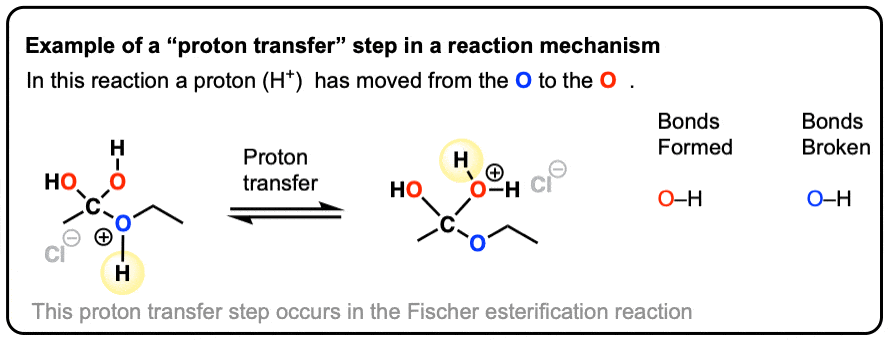
- There are two general ways of drawing the mechanism for proton transfer reactions.
- The most correct way is to use a molecule like H2O that can serve as a “proton shuttle”. The proton transfer mechanism can then be shown via two consecutive acid-base reactions. (Protonation-Deprotonation or Deprotonation-Protonation ; when drawing these mechanisms, make sure to avoid making molecules that have a net charge of +2 or -2 !)
- Alternatively, proton transfer can be drawn as an intramolecular process. This is most likely when a relatively unstrained 5- or 6-membered transition state can be drawn.
Proton transfer is a key step in many reactions of neutral nucleophiles with carbonyl compounds, and often precedes elimination of a leaving group. (See post: Addition-Elimination Mechanisms of Neutral Nucleophiles)
Table of Contents
- What Is “Proton Transfer”?
- The Two-Step “Never-Fail” Mechanism For Most Proton Transfer Reactions
- A Tempting (But Generally Wrong) Mechanism For Proton Transfer
- Proton Transfer Under Neutral Conditions
- Proton Transfer Under Basic Conditions (e.g. Enolates)
- Intramolecular Proton Transfer Reactions Can Sometimes Be OK
- The Magic Wand of Proton Transfer
- Summary
- Notes
- Quiz Yourself!
- (Advanced) References and Further Reading
1. What is Proton Transfer
All acid-base reactions involve the formation and breakage of a bond to a proton (H+). So all acid-base reactions are technically “proton transfer” reactions.
However, the term “proton transfer” is often used to refer to processes like this one.
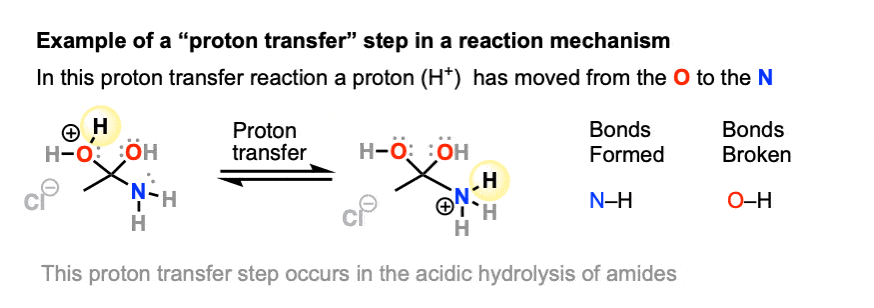
In this specific reaction a bond to H+ is formed (N-H), and a bond to H+ is broken (O-H).
These processes often occur in the reactions of the carbonyl group. Since the conjugate acid is a better leaving group, a proton transfer often precedes an elimination step. [See post: Carbonyl Mechanisms – Addition-Elimination]
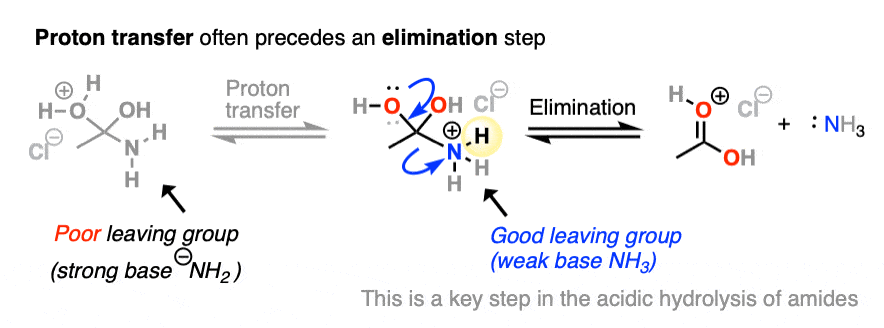
In this article, I’ll briefly show a simple, two-step never-fail “proton shuttle” mechanism for drawing proton transfer in the section below.
Then I’ll show another example of how not to draw the mechanism.
Then we’ll go over examples of proton transfer under neutral and basic conditions.
I’ll finish up with drawing a time saving “cheat” that you will inevitably use if you ever take advanced courses in organic chemistry.
2. The Two-Step “Proton Shuttle” Mechanism For Drawing A Proton Transfer
In 90% of the cases where you will be asked to draw the mechanism of a proton transfer it will involve a positively charged starting material going to a positively charged product. (This generally happens under acidic conditions)
One example of this type of proton transfer we’ve covered before is in the formation of an acetal from an aldehyde or ketone (See post: Hydrates, Hemiacetals, and Acetals) like this:
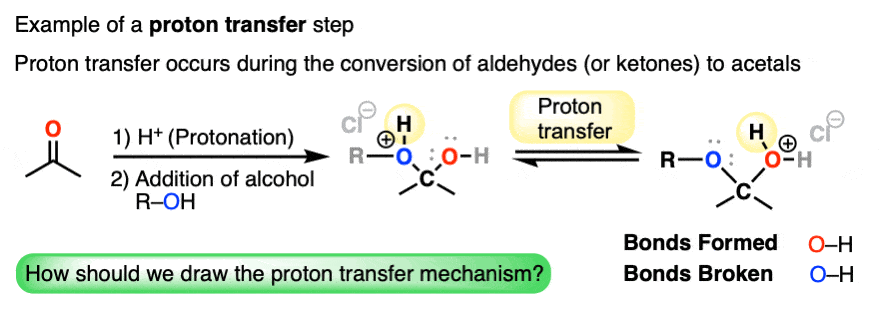
Any mechanism for this reaction has to show breakage of O-H and formation of O-H. In other words, one atom undergoes protonation and another undergoes deprotonation.
There are two common ways to draw this mechanism.
- As a series of two intermolecular acid-base reactions starting with a weak base ” B: ” (specific examples of “B: ” include water or alcohols)
- As a single intramolecular step (not recommended)
If you are asked to draw this mechanism I strongly recommend using the following two-step mechanism. [Note 1]
In the first step, a weak base (such as water, H2O) acts as a base, breaking O-H and resulting in a neutral species.
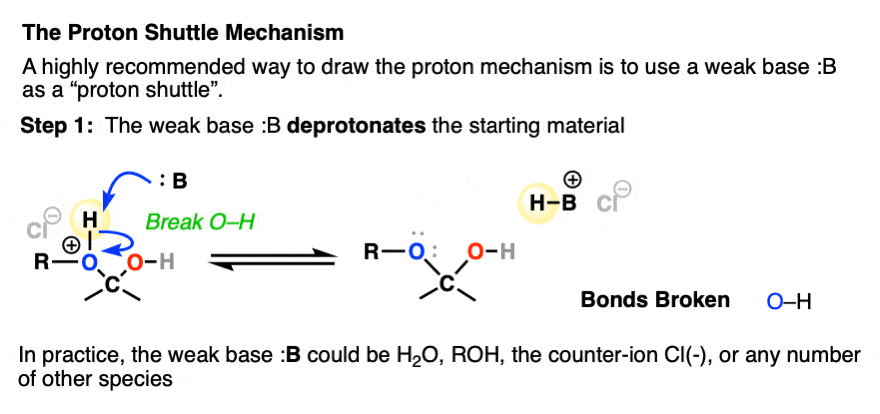
The second step of the proton-transfer mechanism is to use the resulting acid (e.g.) H3O+ to form the desired bond to H.
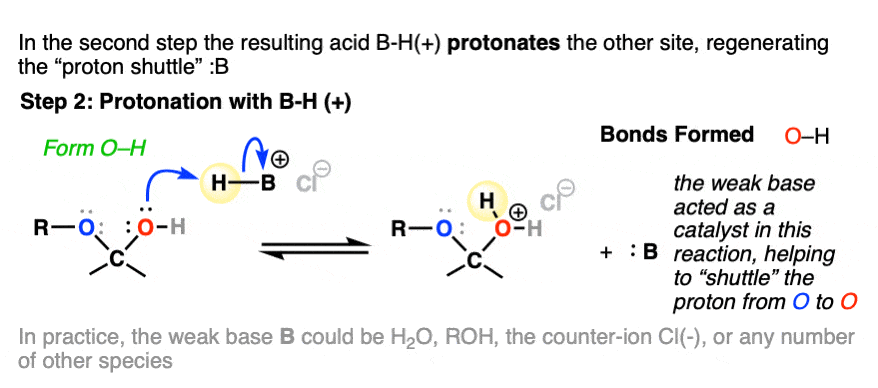
Together, these two steps (Deprotonation – Protonation) have resulted in the movement of a proton from one atom to another.
That’s it. Proton transfer accomplished!
Note how our weak base (e.g. H2O) helps to transport the proton from one atom to another. For this reason the weak base in this reaction is often called a “proton shuttle“.
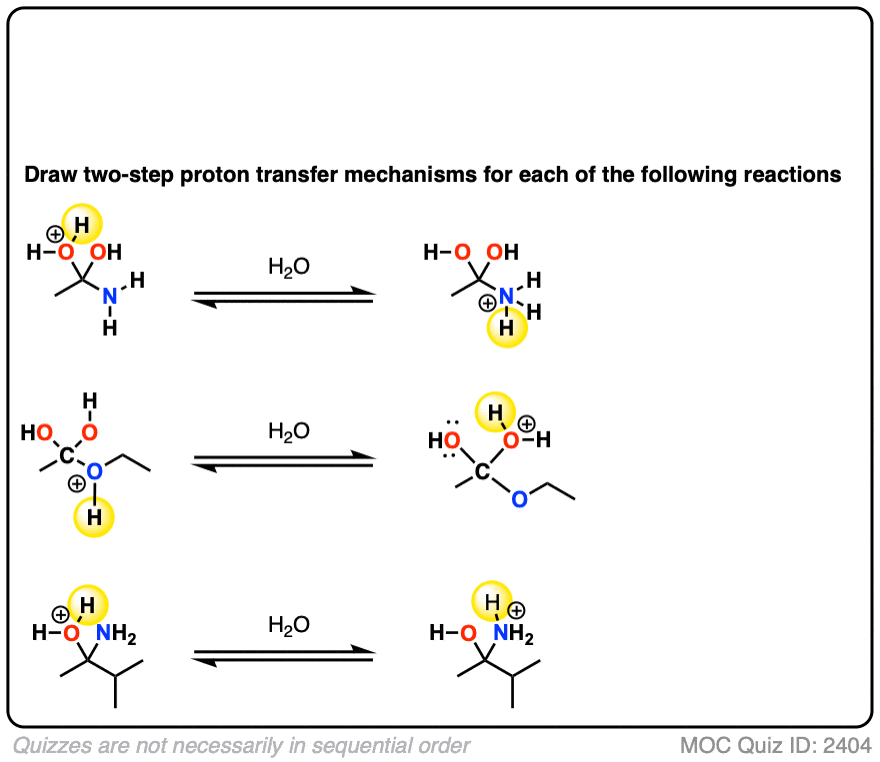 Click to Flip
Click to Flip
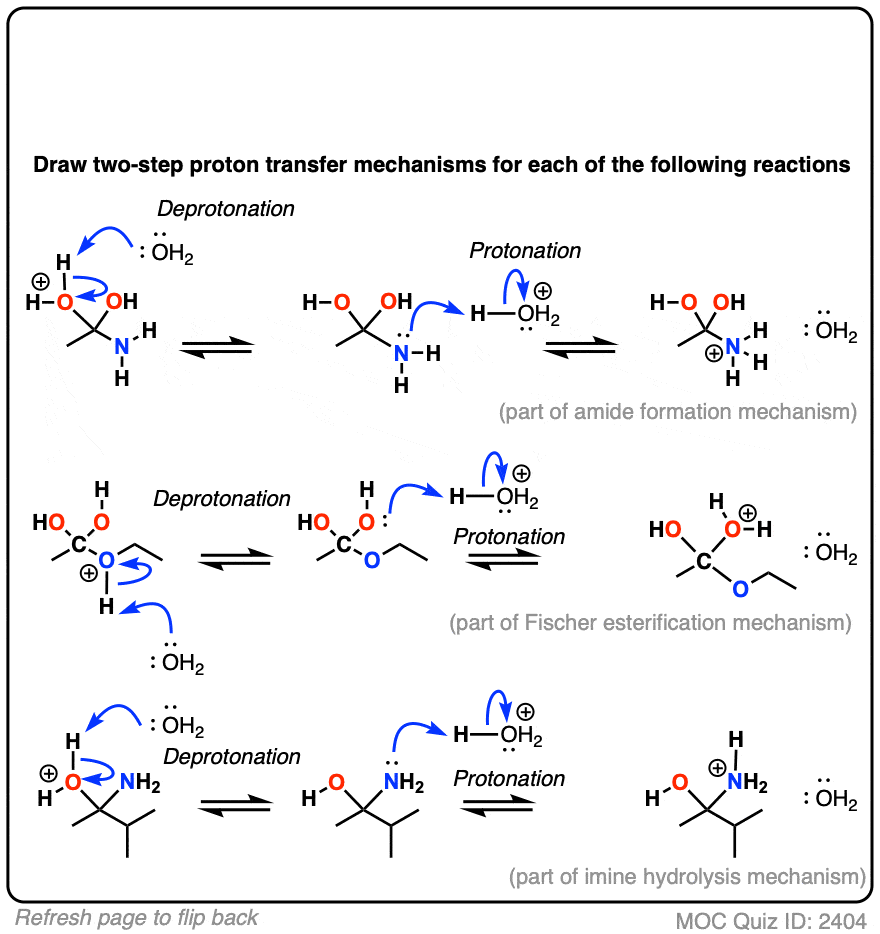
An alternative two-step mechanism is shown below involving Protonation – Deprotonation.
Do you think this is a reasonable alternative? Why or why not?
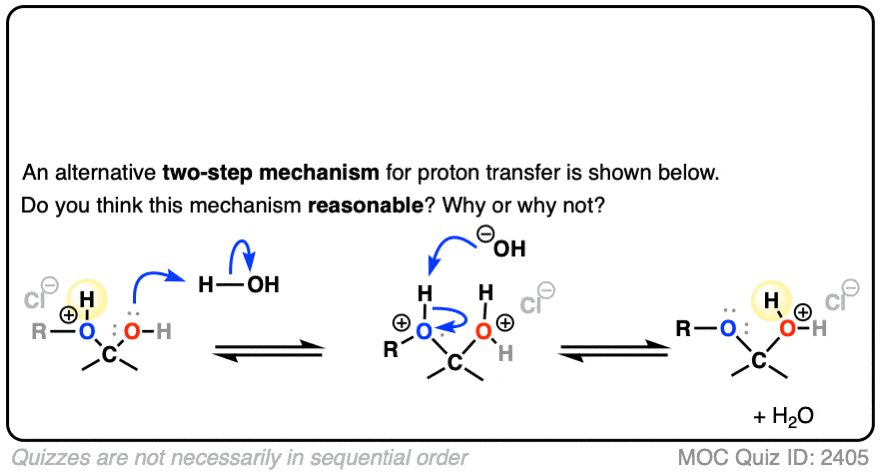 Click to Flip
Click to Flip
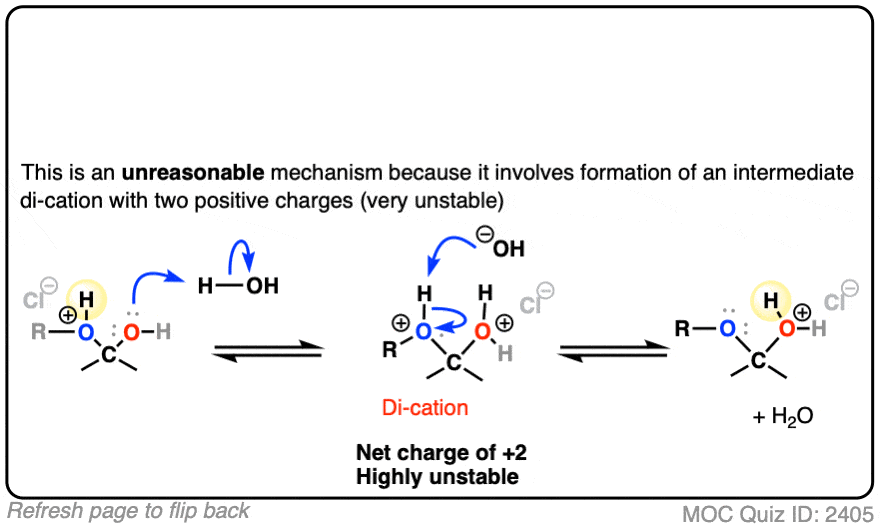
3. The Tempting (But Less Rigorous) One-Step Mechanism For Proton Transfer
I’ve never personally seen the two-step proton shuttle mechanism marked as “wrong” on an exam.
For that reason I pretty much guarantee that you will not be penalized for writing out a proton transfer mechanism in this way.
I can’t say the same thing for the intramolecular mechanism below, however:
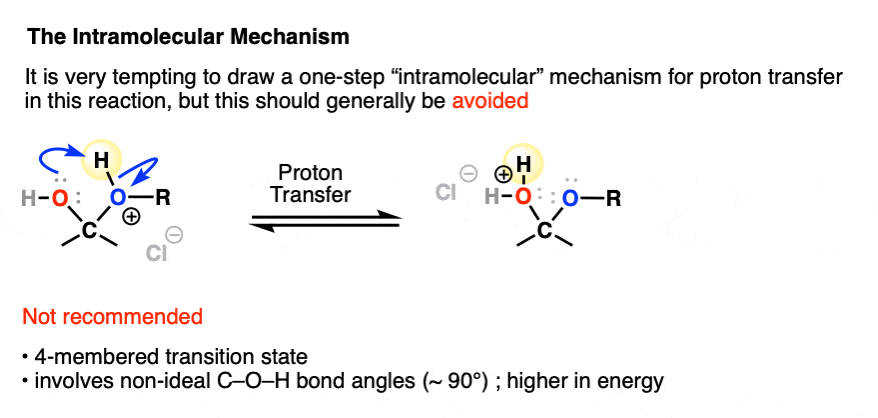
Let’s just acknowledge that drawing the proton transfer in this way is very tempting. First of all, drawing this mechanism only requires two arrows instead of four, and happens in one step instead of two.
Secondly,the base is soooo close to the proton. I mean, it’s right there. What’s not to like?
Be warned, however. It is also the kind of mechanism that many instructors will frown on because it involves a 4-membered transition state.
A four-membered transition state would involve some less-than-ideal geometry and bond angles in the atoms undergoing the proton transfer. A transition state where C-O-H adopts a bond angle of around 90° (as opposed to the preferred near-tetrahedral angle of around 107°) is going to be energetically unfavorable.
For this reason, if you draw the mechanism this way, don’t be surprised if you get a slap on the wrist. But don’t trust me. Check with your instructor.
For what it’s worth, experimental evidence generally does not support the intramolecular mechanism in these cases. [Note 2]
4. Proton Transfer Under Neutral Conditions
The above section covers 90% of the proton transfer mechanisms you’re likely to see. But for completeness we should round out the discussion with some examples of proton transfers under neutral and basic conditions.
Let’s look at proton transfer under neutral conditions first.
A classic example of a proton transfer reaction under neutral conditions is found in the formation of a hemiacetal through addition of an alcohol to an aldehyde (or ketone).
The first step is nucleophilic addition of the alcohol to the ketone. This results in the formation of a new species which possesses both a negative and positive charge. This doubly charged species with no net charge is referred to as a zwitterion.
To get to our neutral hemiacetal a proton transfer must occur.
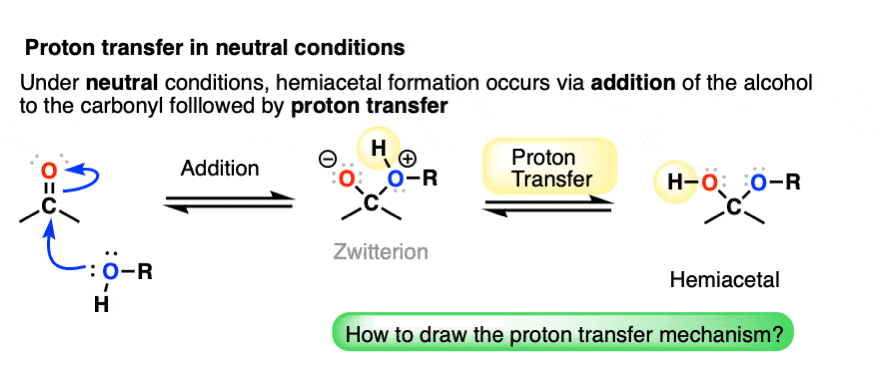
How do we best draw the proton transfer mechanism in this case?
Again, I strongly recommend drawing this as a two-step process.
- In the first step, we could use a molecule of the alcohol to deprotonate OH2 to give OH.
- We could then protonate the O(-) with the resulting ROH2(+) to give OH.
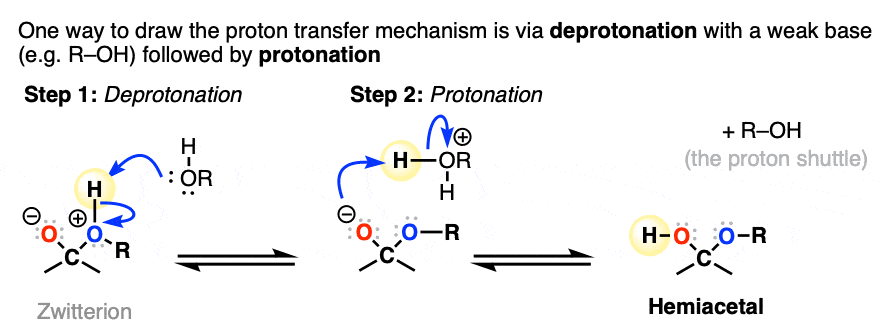
There is also a second, completely valid way to draw the mechanism.
Can you find it? To see the answer, hover here or click this link. [Note 3].
See if you can draw mechanisms for these cases
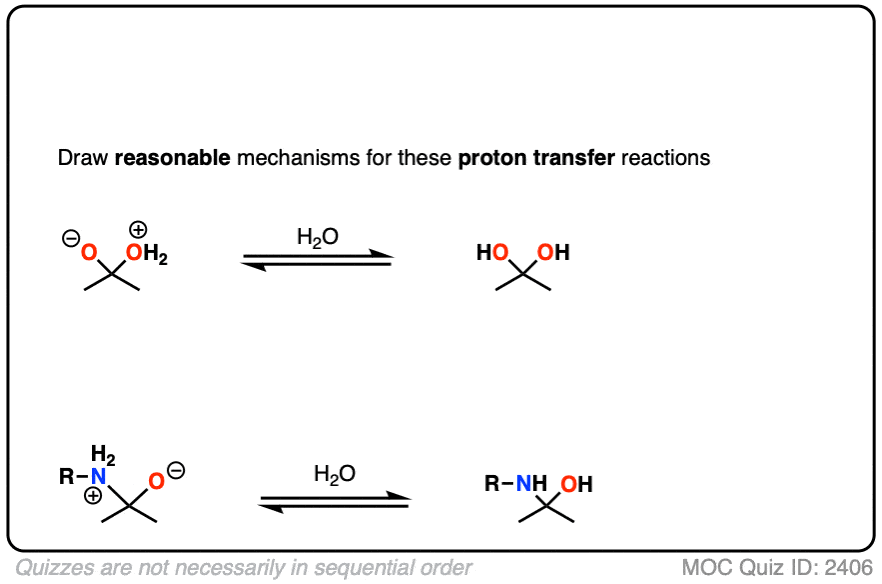 Click to Flip
Click to Flip
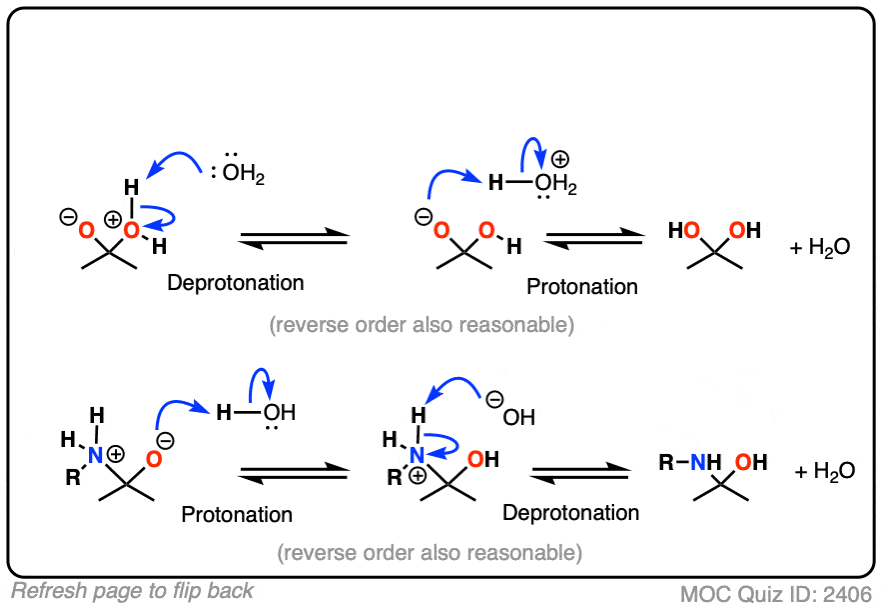
5. Proton Transfer Under Basic Conditions – Robinson
A third category of proton transfer reactions are those where a proton is transferred under basic conditions.
In this case the first step is generally protonation followed by deprotonation.
See if you can draw this proton transfer using H2O as a proton shuttle.
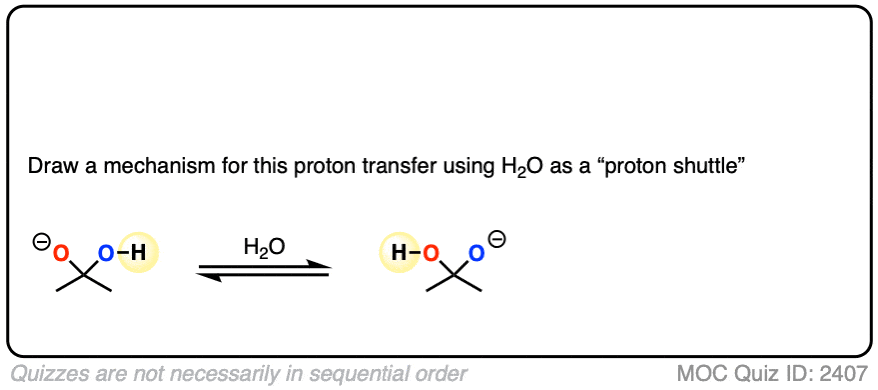 Click to Flip
Click to Flip
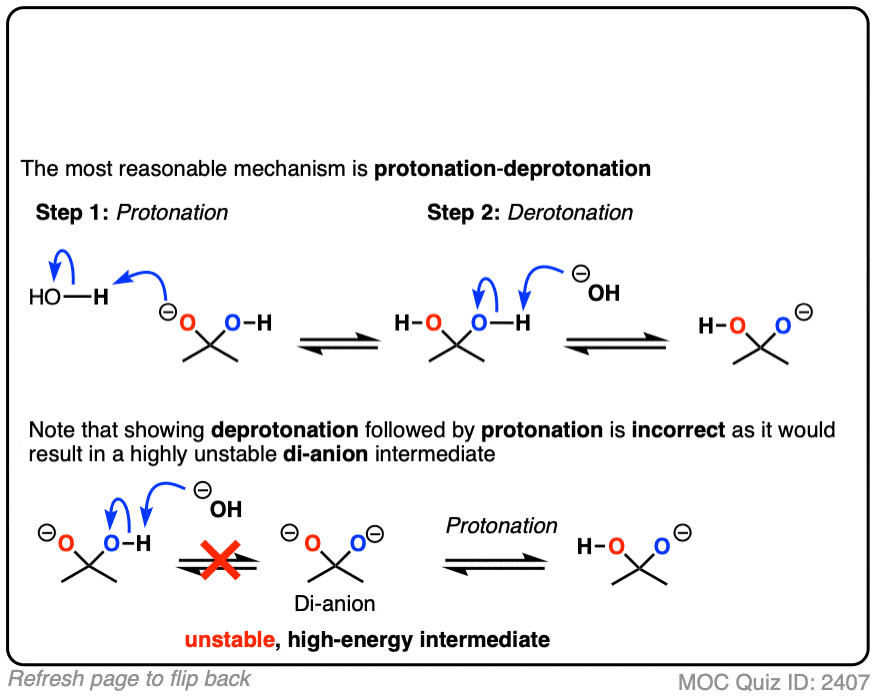
As noted in the quiz, the wrong way to do it would be to deprotonate first, since this would result in a di-anion (unstable!).
Proton transfer under basic conditions comes up from time to time in important mechanisms.
One specific example is found in the Robinson annulation reaction (See post: The Robinson Annulation) which contains a step where a negatively charged species (an enolate) is transformed into a different enolate.
(These are not resonance forms!)
In this reaction C-H is broken and C-H is formed.
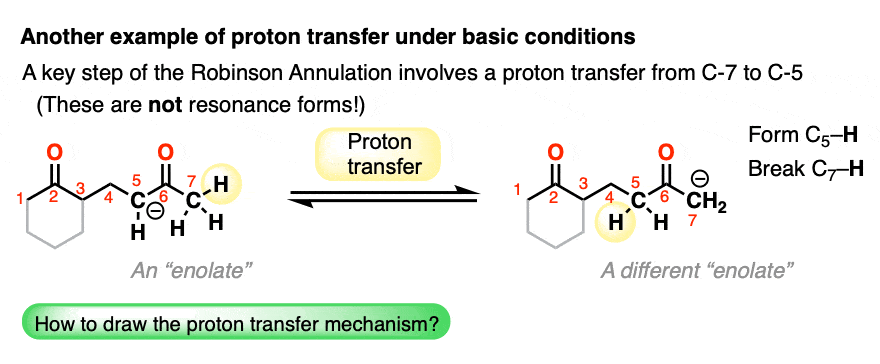
The order in which these steps should occur is 1) Protonation 2) Deprotonation.
One way to show this proton transfer would be with H2O as a proton shuttle (assuming NaOH was used as base).
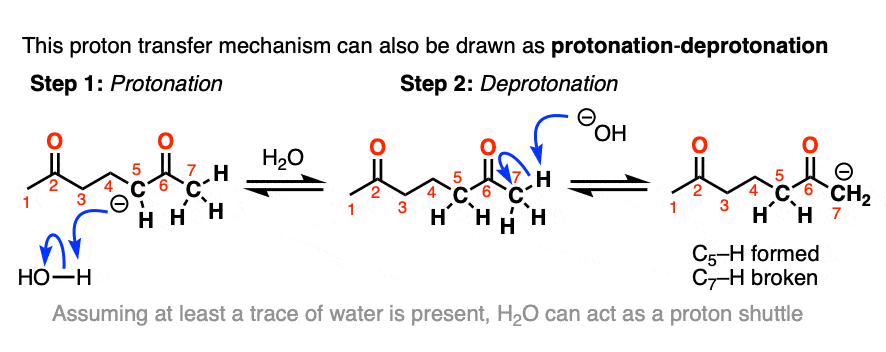
This is another case where drawing an intramolecular proton transfer would be very bad since it would again involve a four-membered transition state.
There is also a way to show the proton transfer here without any involvement by H2O. See this quiz for an example.
6. Intramolecular Proton Transfer Reactions (Are Sometimes OK)
As noted previously, drawing intramolecular proton transfers is generally not something I recommend. However, if proton transfer involves a relatively unstrained cyclic transition state (say, 5- membered or above) then drawing a concerted intramolecular transition state is fine.
These are perfectly acceptable proton transfer reactions, for example.

The two-step mechanism is also valid
7. The Magic Wand of Proton Transfer
Ultimately. proton transfer is one of those very mundane reactions that isn’t very interesting.
It’s quite possibly the least sexy reaction in organic chemistry.
It can occur via multiple paths. Many equivalent mechanisms can be drawn depending on what molecule you choose as a proton shuttle.
Furthermore detailed studies on proton transfer mechanisms indicate it is even more complicated than what I have described here. [Note 2]
It’s a lot of work for what is essentially a very boring reaction. Nobody really cares how it happens. You just want to transfer the damn proton and move on with your life.
For that reason, once students reach a certain assumed level of competence, you may notice instructors (and teaching assistants) will start to just draw proton transfer in the following way.
You just write “proton transfer” (or better yet, “PT” ) and be done with it.

Then you move on to more interesting parts of the mechanism.
I fondly refer to this as the magic wand of proton transfer.
8. Summary
If you’re drawing proton transfer, there are just a few things to keep in mind:
- Avoid drawing intermediates that have multiple charges (no di-cations or di-anions! )
- Avoid drawing strained 3- or 4-membered rings for intramolecular proton transfer (avoid ring strain)
- Use a weak base present in solution as a “proton shuttle“
In many cases, especially in the reactions of aldehydes and ketones, a proton transfer step generally precedes an elimination step.
The common “PADPED” pattern (Protonation-Addition-Deprotonation-Protonation-Elimination-Deprotonation) that applies to a large number of carboxylic acid derivatives has a proton transfer (D – P for Deprotonation-Protonation) right before the Elimination step.)
See the post on the PADPED pattern for more (See article: Making Music With Mechanisms – PADPED)
Notes
Related Articles
- Nucleophilic Acyl Substitution (With Negatively Charged Nucleophiles)
- Addition-Elimination Mechanisms With Neutral Nucleophiles (Including Acid Catalysis)
- Acetals and Hemiacetals
- Basic Hydrolysis of Esters – Saponification
- How to Use a pKa Table
- Thionyl Chloride (SOCl2)
- Imines – Properties, Formation, Reactions, and Mechanisms
- The Robinson Annulation
- Fischer Esterification – Carboxylic Acid to Ester Under Acidic Conditions
Note 1. One comment from a Brandeis University student (from another post): “My prof doesn’t let us draw one-step mechanisms for proton transfer”
Note 2. A study on the mechanism of the hydration and dehydration of ketones indicated that the most likely mechanism for the proton transfer step involved a transition state incorporating two or three equivalents of water, like this [Ref]
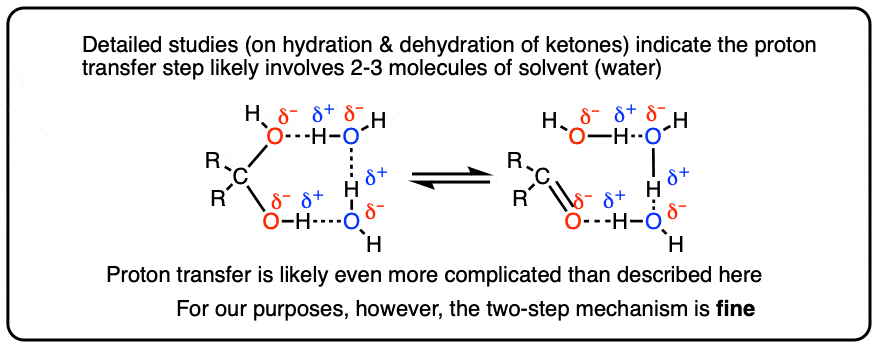
For our purposes, however, the two step “proton shuttle” mechanism is fine. It’s an oversimplification, but an oversimplification we can live with.
Note 3. Protonation of the O(-) gives a neutral intermediate, so that is also fine!
Quiz Yourself!
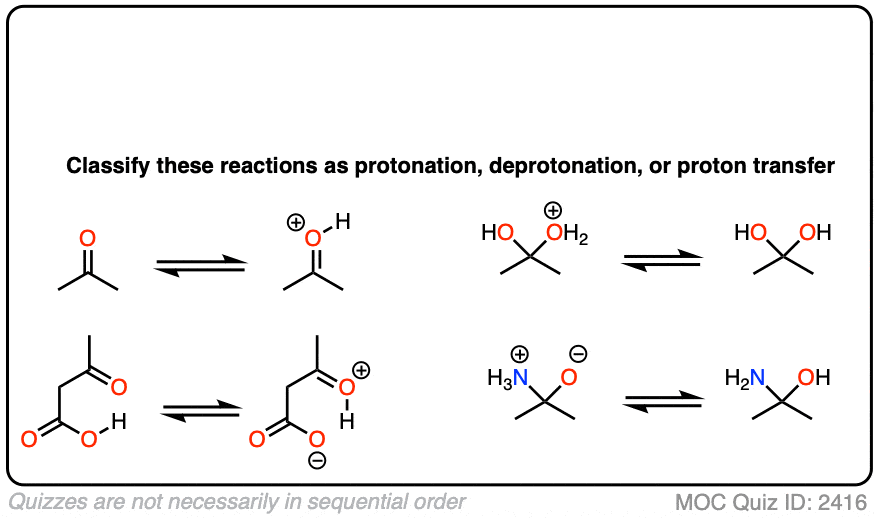 Click to Flip
Click to Flip
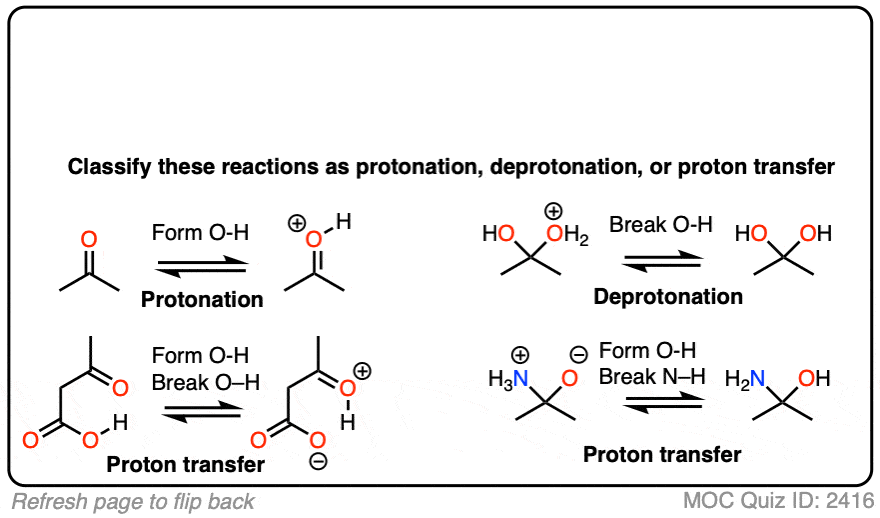
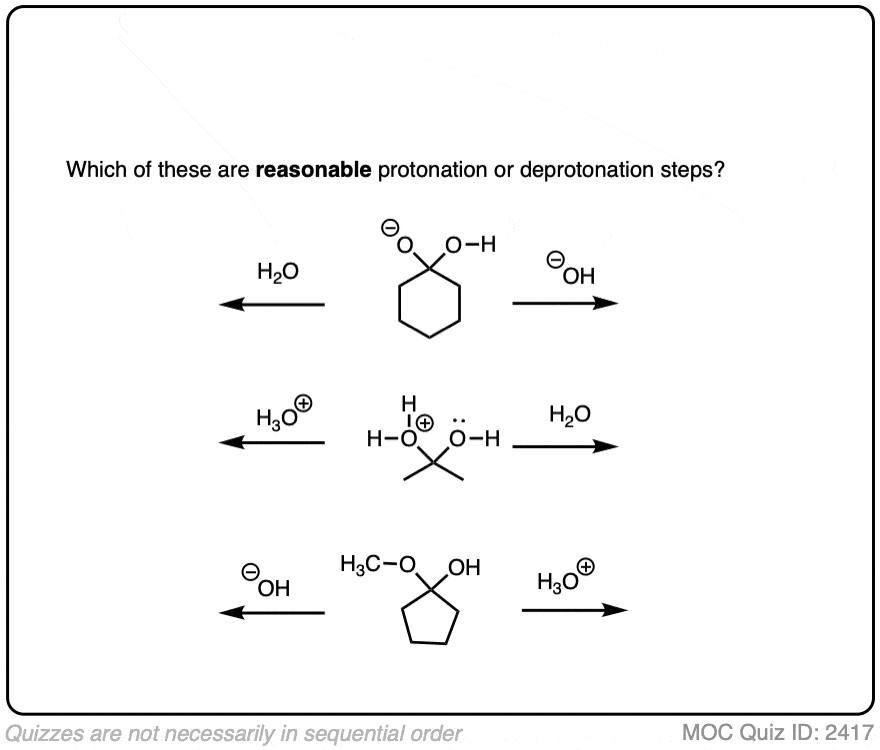 Click to Flip
Click to Flip
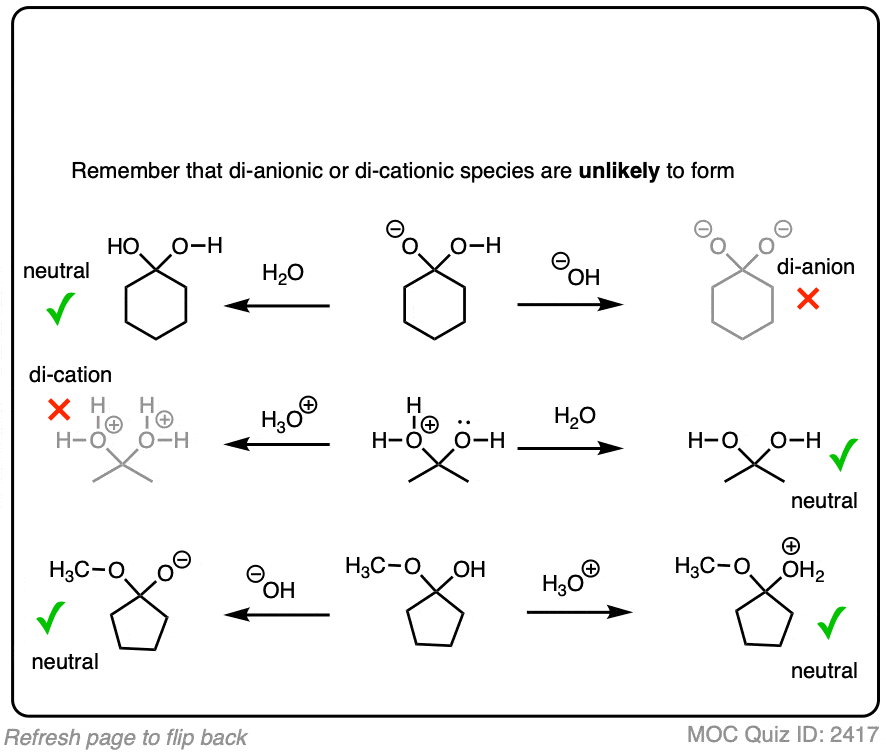
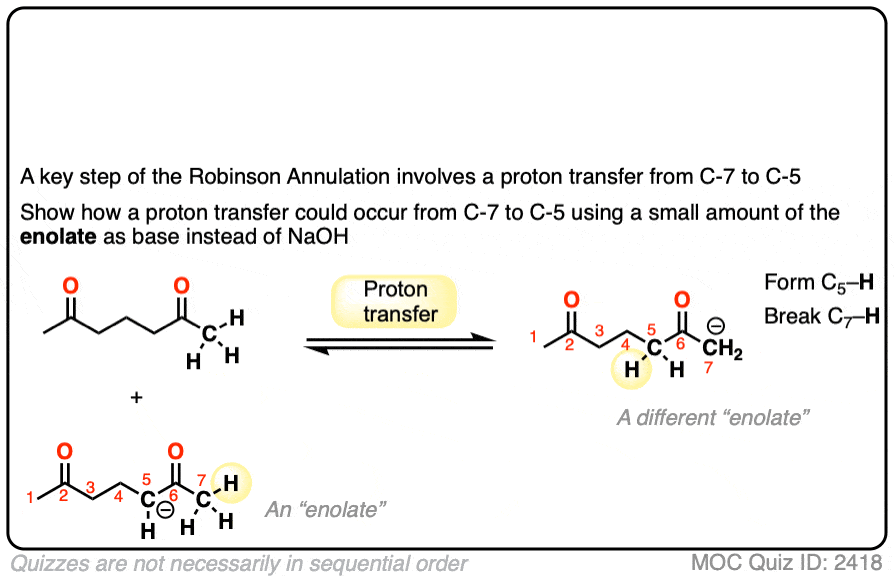 Click to Flip
Click to Flip
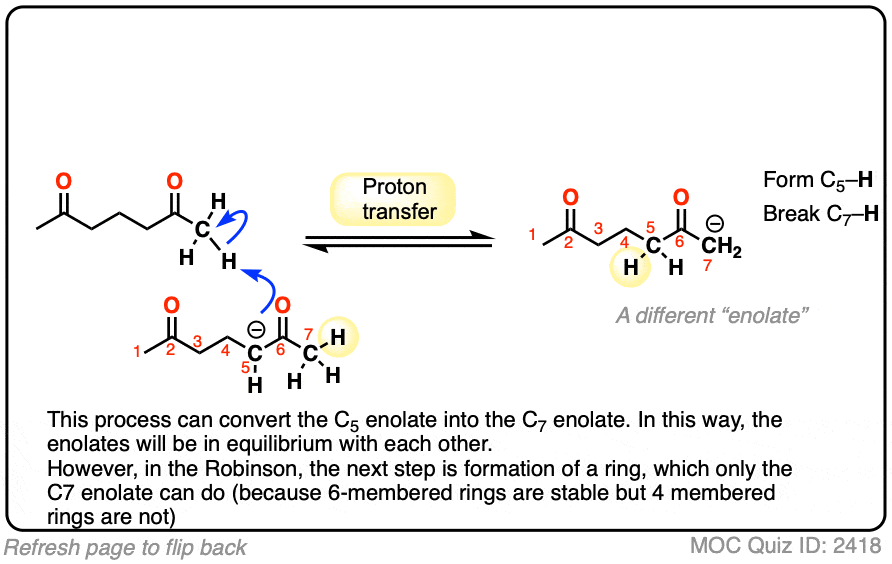
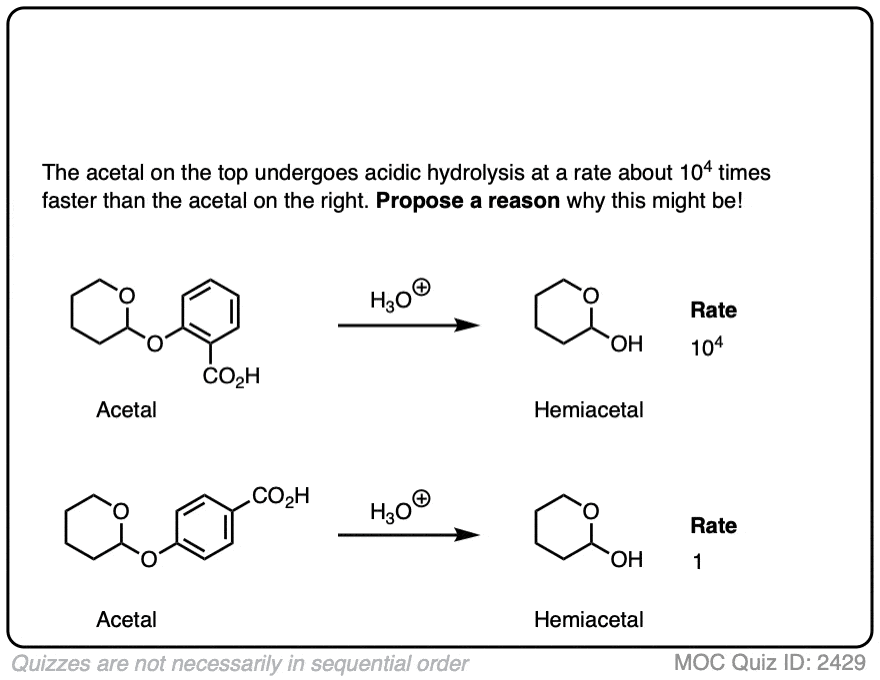 Click to Flip
Click to Flip
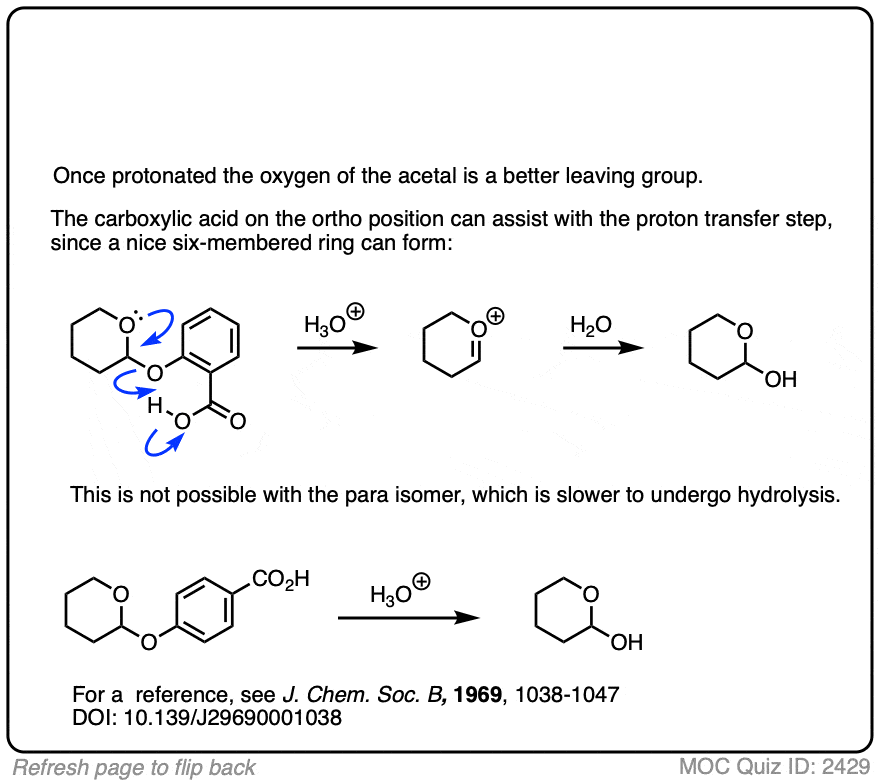
(Advanced) References and Further Reading
Proton Transfer Reactions edited by E.F. Caldin and V. Gold (Chapman and Hall, 1975) was extremely useful in finding references on the mechanism of proton transfer reactions, particularly chapter 11.
Another classic reference is The Proton In Chemistry by R. P. Bell.
- The Acid-Base-Catalyzed Mutarotation of α-D-Tetramethylglucose in Mixed H2O-D2O Solvents1
H. H. Huang, R. R. Robinson, and F. A. Long
Journal of the American Chemical Society 1966 88 (9), 1866-187
DOI: 10.1021/ja00961a003
The authors measure the rate of mutarotation (which involves proton transfer via hemiacetal formation/cleavage) and measure the rate constants for reactions in D2O and H2O with 4 different catalysts. Based on this data, a transition state with two to three solvent molecules of H2O is proposed for the proton transfer step. - Kinetics of Proton Transfer Processes
M. Eigen
Discuss. Faraday Soc., 1965,39, 7-15
DOI: 10.1039/DF9653900007
Proposes a transition state for hydration containing two or more water molecules in a concerted process involving a hydrogen-bonded transition state, since estimates of the absolute rates of individual, stepwise acid-base reactions led to impossibly high rate constants in certain cases. - Kinetics of the reversible hydration of 1,3-dichloroacetone in dioxane and acetonitrile solution
Ronald Percy Bell, J. P. Millington and Judith M. Pink
Proceedings of the Royal Society A 1968, 303, 1-16
DOI: 10.1098/rspa.1968.0036
Study on the mechanism of hydration of 1,3-dichloroacetone, proposes that: “…the uncatalyzed hydration reaction takes place with the cooperation of three water molecules, one or two of which can be replaced with a catalyst molecule”. - Intramolecular Catalysis in the hydrolysis of glycosides and acetals
B. Capon, M.C. Smith et. al.
J. Chem. Soc. B. 1969, 1038-1047
DOI: 10.1039/J29690001038
Example of an acetal hydrolysis reaction where the rate is greatly accelerated due to an intramolecular proton transfer. - What makes proton transfer fast?
Alexander J. Kresge
Accounts of Chemical Research 1975 8 (10), 354-360
DOI: 10.1021/ar50094a006
A very readable Account on what makes certain proton transfers fast and others very slow.
00 General Chemistry Review
01 Bonding, Structure, and Resonance
- How Do We Know Methane (CH4) Is Tetrahedral?
- Hybrid Orbitals and Hybridization
- How To Determine Hybridization: A Shortcut
- Orbital Hybridization And Bond Strengths
- Sigma bonds come in six varieties: Pi bonds come in one
- A Key Skill: How to Calculate Formal Charge
- The Four Intermolecular Forces and How They Affect Boiling Points
- 3 Trends That Affect Boiling Points
- How To Use Electronegativity To Determine Electron Density (and why NOT to trust formal charge)
- Introduction to Resonance
- How To Use Curved Arrows To Interchange Resonance Forms
- Evaluating Resonance Forms (1) - The Rule of Least Charges
- How To Find The Best Resonance Structure By Applying Electronegativity
- Evaluating Resonance Structures With Negative Charges
- Evaluating Resonance Structures With Positive Charge
- Exploring Resonance: Pi-Donation
- Exploring Resonance: Pi-acceptors
- In Summary: Evaluating Resonance Structures
- Drawing Resonance Structures: 3 Common Mistakes To Avoid
- How to apply electronegativity and resonance to understand reactivity
- Bond Hybridization Practice
- Structure and Bonding Practice Quizzes
- Resonance Structures Practice
02 Acid Base Reactions
- Introduction to Acid-Base Reactions
- Acid Base Reactions In Organic Chemistry
- The Stronger The Acid, The Weaker The Conjugate Base
- Walkthrough of Acid-Base Reactions (3) - Acidity Trends
- Five Key Factors That Influence Acidity
- Acid-Base Reactions: Introducing Ka and pKa
- How to Use a pKa Table
- The pKa Table Is Your Friend
- A Handy Rule of Thumb for Acid-Base Reactions
- Acid Base Reactions Are Fast
- pKa Values Span 60 Orders Of Magnitude
- How Protonation and Deprotonation Affect Reactivity
- Acid Base Practice Problems
03 Alkanes and Nomenclature
- Meet the (Most Important) Functional Groups
- Condensed Formulas: Deciphering What the Brackets Mean
- Hidden Hydrogens, Hidden Lone Pairs, Hidden Counterions
- Don't Be Futyl, Learn The Butyls
- Primary, Secondary, Tertiary, Quaternary In Organic Chemistry
- Branching, and Its Affect On Melting and Boiling Points
- The Many, Many Ways of Drawing Butane
- Wedge And Dash Convention For Tetrahedral Carbon
- Common Mistakes in Organic Chemistry: Pentavalent Carbon
- Table of Functional Group Priorities for Nomenclature
- Summary Sheet - Alkane Nomenclature
- Organic Chemistry IUPAC Nomenclature Demystified With A Simple Puzzle Piece Approach
- Boiling Point Quizzes
- Organic Chemistry Nomenclature Quizzes
04 Conformations and Cycloalkanes
- Staggered vs Eclipsed Conformations of Ethane
- Conformational Isomers of Propane
- Newman Projection of Butane (and Gauche Conformation)
- Introduction to Cycloalkanes
- Geometric Isomers In Small Rings: Cis And Trans Cycloalkanes
- Calculation of Ring Strain In Cycloalkanes
- Cycloalkanes - Ring Strain In Cyclopropane And Cyclobutane
- Cyclohexane Conformations
- Cyclohexane Chair Conformation: An Aerial Tour
- How To Draw The Cyclohexane Chair Conformation
- The Cyclohexane Chair Flip
- The Cyclohexane Chair Flip - Energy Diagram
- Substituted Cyclohexanes - Axial vs Equatorial
- Ranking The Bulkiness Of Substituents On Cyclohexanes: "A-Values"
- Cyclohexane Chair Conformation Stability: Which One Is Lower Energy?
- Fused Rings - Cis-Decalin and Trans-Decalin
- Naming Bicyclic Compounds - Fused, Bridged, and Spiro
- Bredt's Rule (And Summary of Cycloalkanes)
- Newman Projection Practice
- Cycloalkanes Practice Problems
05 A Primer On Organic Reactions
- The Most Important Question To Ask When Learning a New Reaction
- Curved Arrows (for reactions)
- Nucleophiles and Electrophiles
- The Three Classes of Nucleophiles
- Nucleophilicity vs. Basicity
- What Makes A Good Nucleophile?
- What Makes A Good Leaving Group?
- 3 Factors That Stabilize Carbocations
- Equilibrium and Energy Relationships
- 7 Factors that stabilize negative charge in organic chemistry
- 7 Factors That Stabilize Positive Charge in Organic Chemistry
- What's a Transition State?
- Hammond's Postulate
- Learning Organic Chemistry Reactions: A Checklist (PDF)
- Introduction to Oxidative Cleavage Reactions
06 Free Radical Reactions
- Free Radical Reactions
- 3 Factors That Stabilize Free Radicals
- Bond Strengths And Radical Stability
- Free Radical Initiation: Why Is "Light" Or "Heat" Required?
- Initiation, Propagation, Termination
- Monochlorination Products Of Propane, Pentane, And Other Alkanes
- Selectivity In Free Radical Reactions
- Selectivity in Free Radical Reactions: Bromination vs. Chlorination
- Halogenation At Tiffany's
- Allylic Bromination
- Bonus Topic: Allylic Rearrangements
- In Summary: Free Radicals
- Synthesis (2) - Reactions of Alkanes
- Free Radicals Practice Quizzes
07 Stereochemistry and Chirality
- Types of Isomers: Constitutional Isomers, Stereoisomers, Enantiomers, and Diastereomers
- How To Draw The Enantiomer Of A Chiral Molecule
- How To Draw A Bond Rotation
- Introduction to Assigning (R) and (S): The Cahn-Ingold-Prelog Rules
- Assigning Cahn-Ingold-Prelog (CIP) Priorities (2) - The Method of Dots
- Enantiomers vs Diastereomers vs The Same? Two Methods For Solving Problems
- Assigning R/S To Newman Projections (And Converting Newman To Line Diagrams)
- How To Determine R and S Configurations On A Fischer Projection
- The Meso Trap
- Optical Rotation, Optical Activity, and Specific Rotation
- Optical Purity and Enantiomeric Excess
- What's a Racemic Mixture?
- Chiral Allenes And Chiral Axes
- Stereochemistry Practice Problems and Quizzes
08 Substitution Reactions
- Nucleophilic Substitution Reactions - Introduction
- Two Types of Nucleophilic Substitution Reactions
- The SN2 Mechanism
- Why the SN2 Reaction Is Powerful
- The SN1 Mechanism
- The Conjugate Acid Is A Better Leaving Group
- Comparing the SN1 and SN2 Reactions
- Polar Protic? Polar Aprotic? Nonpolar? All About Solvents
- Steric Hindrance is Like a Fat Goalie
- Common Blind Spot: Intramolecular Reactions
- Substitution Practice - SN1
- Substitution Practice - SN2
09 Elimination Reactions
- Elimination Reactions (1): Introduction And The Key Pattern
- Elimination Reactions (2): The Zaitsev Rule
- Elimination Reactions Are Favored By Heat
- Two Elimination Reaction Patterns
- The E1 Reaction
- The E2 Mechanism
- E1 vs E2: Comparing the E1 and E2 Reactions
- Antiperiplanar Relationships: The E2 Reaction and Cyclohexane Rings
- Bulky Bases in Elimination Reactions
- Comparing the E1 vs SN1 Reactions
- Elimination (E1) Reactions With Rearrangements
- E1cB - Elimination (Unimolecular) Conjugate Base
- Elimination (E1) Practice Problems And Solutions
- Elimination (E2) Practice Problems and Solutions
10 Rearrangements
11 SN1/SN2/E1/E2 Decision
- Identifying Where Substitution and Elimination Reactions Happen
- Deciding SN1/SN2/E1/E2 (1) - The Substrate
- Deciding SN1/SN2/E1/E2 (2) - The Nucleophile/Base
- SN1 vs E1 and SN2 vs E2 : The Temperature
- Deciding SN1/SN2/E1/E2 - The Solvent
- Wrapup: The Key Factors For Determining SN1/SN2/E1/E2
- Alkyl Halide Reaction Map And Summary
- SN1 SN2 E1 E2 Practice Problems
12 Alkene Reactions
- E and Z Notation For Alkenes (+ Cis/Trans)
- Alkene Stability
- Alkene Addition Reactions: "Regioselectivity" and "Stereoselectivity" (Syn/Anti)
- Stereoselective and Stereospecific Reactions
- Hydrohalogenation of Alkenes and Markovnikov's Rule
- Hydration of Alkenes With Aqueous Acid
- Rearrangements in Alkene Addition Reactions
- Halogenation of Alkenes and Halohydrin Formation
- Oxymercuration Demercuration of Alkenes
- Hydroboration Oxidation of Alkenes
- m-CPBA (meta-chloroperoxybenzoic acid)
- OsO4 (Osmium Tetroxide) for Dihydroxylation of Alkenes
- Palladium on Carbon (Pd/C) for Catalytic Hydrogenation of Alkenes
- Cyclopropanation of Alkenes
- A Fourth Alkene Addition Pattern - Free Radical Addition
- Alkene Reactions: Ozonolysis
- Summary: Three Key Families Of Alkene Reaction Mechanisms
- Synthesis (4) - Alkene Reaction Map, Including Alkyl Halide Reactions
- Alkene Reactions Practice Problems
13 Alkyne Reactions
- Acetylides from Alkynes, And Substitution Reactions of Acetylides
- Partial Reduction of Alkynes With Lindlar's Catalyst
- Partial Reduction of Alkynes With Na/NH3 To Obtain Trans Alkenes
- Alkyne Hydroboration With "R2BH"
- Hydration and Oxymercuration of Alkynes
- Hydrohalogenation of Alkynes
- Alkyne Halogenation: Bromination and Chlorination of Alkynes
- Oxidation of Alkynes With O3 and KMnO4
- Alkenes To Alkynes Via Halogenation And Elimination Reactions
- Alkynes Are A Blank Canvas
- Synthesis (5) - Reactions of Alkynes
- Alkyne Reactions Practice Problems With Answers
14 Alcohols, Epoxides and Ethers
- Alcohols - Nomenclature and Properties
- Alcohols Can Act As Acids Or Bases (And Why It Matters)
- Alcohols - Acidity and Basicity
- The Williamson Ether Synthesis
- Ethers From Alkenes, Tertiary Alkyl Halides and Alkoxymercuration
- Alcohols To Ethers via Acid Catalysis
- Cleavage Of Ethers With Acid
- Epoxides - The Outlier Of The Ether Family
- Opening of Epoxides With Acid
- Epoxide Ring Opening With Base
- Making Alkyl Halides From Alcohols
- Tosylates And Mesylates
- PBr3 and SOCl2
- Elimination Reactions of Alcohols
- Elimination of Alcohols To Alkenes With POCl3
- Alcohol Oxidation: "Strong" and "Weak" Oxidants
- Demystifying The Mechanisms of Alcohol Oxidations
- Protecting Groups For Alcohols
- Thiols And Thioethers
- Calculating the oxidation state of a carbon
- Oxidation and Reduction in Organic Chemistry
- Oxidation Ladders
- SOCl2 Mechanism For Alcohols To Alkyl Halides: SN2 versus SNi
- Alcohol Reactions Roadmap (PDF)
- Alcohol Reaction Practice Problems
- Epoxide Reaction Quizzes
- Oxidation and Reduction Practice Quizzes
15 Organometallics
- What's An Organometallic?
- Formation of Grignard and Organolithium Reagents
- Organometallics Are Strong Bases
- Reactions of Grignard Reagents
- Protecting Groups In Grignard Reactions
- Synthesis Problems Involving Grignard Reagents
- Grignard Reactions And Synthesis (2)
- Organocuprates (Gilman Reagents): How They're Made
- Gilman Reagents (Organocuprates): What They're Used For
- The Heck, Suzuki, and Olefin Metathesis Reactions (And Why They Don't Belong In Most Introductory Organic Chemistry Courses)
- Reaction Map: Reactions of Organometallics
- Grignard Practice Problems
16 Spectroscopy
- Degrees of Unsaturation (or IHD, Index of Hydrogen Deficiency)
- Conjugation And Color (+ How Bleach Works)
- Introduction To UV-Vis Spectroscopy
- UV-Vis Spectroscopy: Absorbance of Carbonyls
- UV-Vis Spectroscopy: Practice Questions
- Bond Vibrations, Infrared Spectroscopy, and the "Ball and Spring" Model
- Infrared Spectroscopy: A Quick Primer On Interpreting Spectra
- IR Spectroscopy: 4 Practice Problems
- 1H NMR: How Many Signals?
- Homotopic, Enantiotopic, Diastereotopic
- Diastereotopic Protons in 1H NMR Spectroscopy: Examples
- 13-C NMR - How Many Signals
- Liquid Gold: Pheromones In Doe Urine
- Natural Product Isolation (1) - Extraction
- Natural Product Isolation (2) - Purification Techniques, An Overview
- Structure Determination Case Study: Deer Tarsal Gland Pheromone
17 Dienes and MO Theory
- What To Expect In Organic Chemistry 2
- Are these molecules conjugated?
- Conjugation And Resonance In Organic Chemistry
- Bonding And Antibonding Pi Orbitals
- Molecular Orbitals of The Allyl Cation, Allyl Radical, and Allyl Anion
- Pi Molecular Orbitals of Butadiene
- Reactions of Dienes: 1,2 and 1,4 Addition
- Thermodynamic and Kinetic Products
- More On 1,2 and 1,4 Additions To Dienes
- s-cis and s-trans
- The Diels-Alder Reaction
- Cyclic Dienes and Dienophiles in the Diels-Alder Reaction
- Stereochemistry of the Diels-Alder Reaction
- Exo vs Endo Products In The Diels Alder: How To Tell Them Apart
- HOMO and LUMO In the Diels Alder Reaction
- Why Are Endo vs Exo Products Favored in the Diels-Alder Reaction?
- Diels-Alder Reaction: Kinetic and Thermodynamic Control
- The Retro Diels-Alder Reaction
- The Intramolecular Diels Alder Reaction
- Regiochemistry In The Diels-Alder Reaction
- The Cope and Claisen Rearrangements
- Electrocyclic Reactions
- Electrocyclic Ring Opening And Closure (2) - Six (or Eight) Pi Electrons
- Diels Alder Practice Problems
- Molecular Orbital Theory Practice
18 Aromaticity
- Introduction To Aromaticity
- Rules For Aromaticity
- Huckel's Rule: What Does 4n+2 Mean?
- Aromatic, Non-Aromatic, or Antiaromatic? Some Practice Problems
- Antiaromatic Compounds and Antiaromaticity
- The Pi Molecular Orbitals of Benzene
- The Pi Molecular Orbitals of Cyclobutadiene
- Frost Circles
- Aromaticity Practice Quizzes
19 Reactions of Aromatic Molecules
- Electrophilic Aromatic Substitution: Introduction
- Activating and Deactivating Groups In Electrophilic Aromatic Substitution
- Electrophilic Aromatic Substitution - The Mechanism
- Ortho-, Para- and Meta- Directors in Electrophilic Aromatic Substitution
- Understanding Ortho, Para, and Meta Directors
- Why are halogens ortho- para- directors?
- Disubstituted Benzenes: The Strongest Electron-Donor "Wins"
- Electrophilic Aromatic Substitutions (1) - Halogenation of Benzene
- Electrophilic Aromatic Substitutions (2) - Nitration and Sulfonation
- EAS Reactions (3) - Friedel-Crafts Acylation and Friedel-Crafts Alkylation
- Intramolecular Friedel-Crafts Reactions
- Nucleophilic Aromatic Substitution (NAS)
- Nucleophilic Aromatic Substitution (2) - The Benzyne Mechanism
- Reactions on the "Benzylic" Carbon: Bromination And Oxidation
- The Wolff-Kishner, Clemmensen, And Other Carbonyl Reductions
- More Reactions on the Aromatic Sidechain: Reduction of Nitro Groups and the Baeyer Villiger
- Aromatic Synthesis (1) - "Order Of Operations"
- Synthesis of Benzene Derivatives (2) - Polarity Reversal
- Aromatic Synthesis (3) - Sulfonyl Blocking Groups
- Birch Reduction
- Synthesis (7): Reaction Map of Benzene and Related Aromatic Compounds
- Aromatic Reactions and Synthesis Practice
- Electrophilic Aromatic Substitution Practice Problems
20 Aldehydes and Ketones
- What's The Alpha Carbon In Carbonyl Compounds?
- Nucleophilic Addition To Carbonyls
- Aldehydes and Ketones: 14 Reactions With The Same Mechanism
- Sodium Borohydride (NaBH4) Reduction of Aldehydes and Ketones
- Grignard Reagents For Addition To Aldehydes and Ketones
- Wittig Reaction
- Hydrates, Hemiacetals, and Acetals
- Imines - Properties, Formation, Reactions, and Mechanisms
- All About Enamines
- Breaking Down Carbonyl Reaction Mechanisms: Reactions of Anionic Nucleophiles (Part 2)
- Aldehydes Ketones Reaction Practice
21 Carboxylic Acid Derivatives
- Nucleophilic Acyl Substitution (With Negatively Charged Nucleophiles)
- Addition-Elimination Mechanisms With Neutral Nucleophiles (Including Acid Catalysis)
- Basic Hydrolysis of Esters - Saponification
- Transesterification
- Proton Transfer
- Fischer Esterification - Carboxylic Acid to Ester Under Acidic Conditions
- Lithium Aluminum Hydride (LiAlH4) For Reduction of Carboxylic Acid Derivatives
- LiAlH[Ot-Bu]3 For The Reduction of Acid Halides To Aldehydes
- Di-isobutyl Aluminum Hydride (DIBAL) For The Partial Reduction of Esters and Nitriles
- Amide Hydrolysis
- Thionyl Chloride (SOCl2) And Conversion of Carboxylic Acids to Acid Halides
- Diazomethane (CH2N2)
- Carbonyl Chemistry: Learn Six Mechanisms For the Price Of One
- Making Music With Mechanisms (PADPED)
- Carboxylic Acid Derivatives Practice Questions
22 Enols and Enolates
- Keto-Enol Tautomerism
- Enolates - Formation, Stability, and Simple Reactions
- Kinetic Versus Thermodynamic Enolates
- Aldol Addition and Condensation Reactions
- Reactions of Enols - Acid-Catalyzed Aldol, Halogenation, and Mannich Reactions
- Claisen Condensation and Dieckmann Condensation
- Decarboxylation
- The Malonic Ester and Acetoacetic Ester Synthesis
- The Michael Addition Reaction and Conjugate Addition
- The Robinson Annulation
- Haloform Reaction
- The Hell–Volhard–Zelinsky Reaction
- Enols and Enolates Practice Quizzes
23 Amines
- The Amide Functional Group: Properties, Synthesis, and Nomenclature
- Basicity of Amines And pKaH
- 5 Key Basicity Trends of Amines
- The Mesomeric Effect And Aromatic Amines
- Nucleophilicity of Amines
- Alkylation of Amines (Sucks!)
- Reductive Amination
- The Gabriel Synthesis
- Some Reactions of Azides
- The Hofmann Elimination
- The Hofmann and Curtius Rearrangements
- The Cope Elimination
- Protecting Groups for Amines - Carbamates
- The Strecker Synthesis of Amino Acids
- Introduction to Peptide Synthesis
- Reactions of Diazonium Salts: Sandmeyer and Related Reactions
- Amine Practice Questions
24 Carbohydrates
- D and L Notation For Sugars
- Pyranoses and Furanoses: Ring-Chain Tautomerism In Sugars
- What is Mutarotation?
- Reducing Sugars
- The Big Damn Post Of Carbohydrate-Related Chemistry Definitions
- The Haworth Projection
- Converting a Fischer Projection To A Haworth (And Vice Versa)
- Reactions of Sugars: Glycosylation and Protection
- The Ruff Degradation and Kiliani-Fischer Synthesis
- Isoelectric Points of Amino Acids (and How To Calculate Them)
- Carbohydrates Practice
- Amino Acid Quizzes
25 Fun and Miscellaneous
- A Gallery of Some Interesting Molecules From Nature
- Screw Organic Chemistry, I'm Just Going To Write About Cats
- On Cats, Part 1: Conformations and Configurations
- On Cats, Part 2: Cat Line Diagrams
- On Cats, Part 4: Enantiocats
- On Cats, Part 6: Stereocenters
- Organic Chemistry Is Shit
- The Organic Chemistry Behind "The Pill"
- Maybe they should call them, "Formal Wins" ?
- Why Do Organic Chemists Use Kilocalories?
- The Principle of Least Effort
- Organic Chemistry GIFS - Resonance Forms
- Reproducibility In Organic Chemistry
- What Holds The Nucleus Together?
- How Reactions Are Like Music
- Organic Chemistry and the New MCAT
26 Organic Chemistry Tips and Tricks
- Common Mistakes: Formal Charges Can Mislead
- Partial Charges Give Clues About Electron Flow
- Draw The Ugly Version First
- Organic Chemistry Study Tips: Learn the Trends
- The 8 Types of Arrows In Organic Chemistry, Explained
- Top 10 Skills To Master Before An Organic Chemistry 2 Final
- Common Mistakes with Carbonyls: Carboxylic Acids... Are Acids!
- Planning Organic Synthesis With "Reaction Maps"
- Alkene Addition Pattern #1: The "Carbocation Pathway"
- Alkene Addition Pattern #2: The "Three-Membered Ring" Pathway
- Alkene Addition Pattern #3: The "Concerted" Pathway
- Number Your Carbons!
- The 4 Major Classes of Reactions in Org 1
- How (and why) electrons flow
- Grossman's Rule
- Three Exam Tips
- A 3-Step Method For Thinking Through Synthesis Problems
- Putting It Together
- Putting Diels-Alder Products in Perspective
- The Ups and Downs of Cyclohexanes
- The Most Annoying Exceptions in Org 1 (Part 1)
- The Most Annoying Exceptions in Org 1 (Part 2)
- The Marriage May Be Bad, But the Divorce Still Costs Money
- 9 Nomenclature Conventions To Know
- Nucleophile attacks Electrophile
27 Case Studies of Successful O-Chem Students
- Success Stories: How Corina Got The The "Hard" Professor - And Got An A+ Anyway
- How Helena Aced Organic Chemistry
- From a "Drop" To B+ in Org 2 – How A Hard Working Student Turned It Around
- How Serge Aced Organic Chemistry
- Success Stories: How Zach Aced Organic Chemistry 1
- Success Stories: How Kari Went From C– to B+
- How Esther Bounced Back From a "C" To Get A's In Organic Chemistry 1 And 2
- How Tyrell Got The Highest Grade In Her Organic Chemistry Course
- This Is Why Students Use Flashcards
- Success Stories: How Stu Aced Organic Chemistry
- How John Pulled Up His Organic Chemistry Exam Grades
- Success Stories: How Nathan Aced Organic Chemistry (Without It Taking Over His Life)
- How Chris Aced Org 1 and Org 2
- Interview: How Jay Got an A+ In Organic Chemistry
- How to Do Well in Organic Chemistry: One Student's Advice
- "America's Top TA" Shares His Secrets For Teaching O-Chem
- "Organic Chemistry Is Like..." - A Few Metaphors
- How To Do Well In Organic Chemistry: Advice From A Tutor
- Guest post: "I went from being afraid of tests to actually looking forward to them".
What about proton transfer in the excited state and f-membered ring??
Sir,
I think I m highly blessed to visit your website!
It shows your extreme dedication towards yur blog . Awesome stuff.
Thanks a lot. :)
The bit about pKa values favoring the proton transfer is valid, but pKa values don’t speak to the speed of a reaction as implied in the text.
pKa values are thermodynamic values. Acidity and basicity are fundamentally thermodynamic values. And although a reaction might be thermodynamically favorable, that doesn’t say anything about the speed or the kinetics of the reaction.
Isn’t pka of water H2O is 16 and you mentioned -1?
It should have been written -OH2(+)